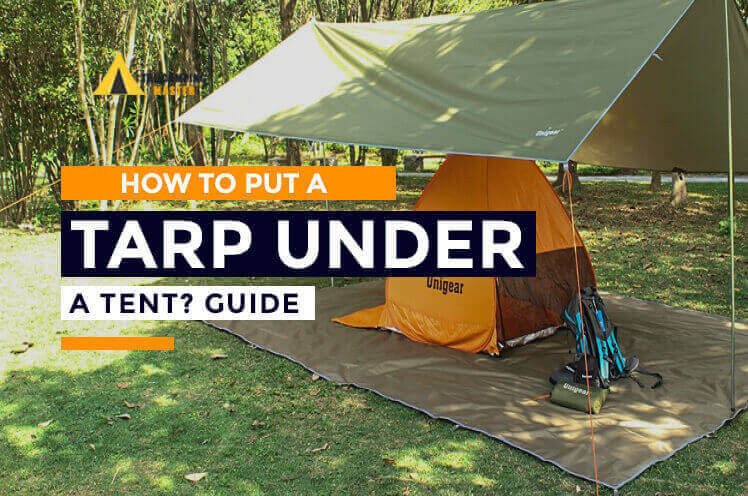In this article, you will learn how to put trap under tent. The steps for placing a tarp are pretty simple, as I have explained below. I have given 10 ways to accomplish it and the reasons for bringing one with you while camping.
Many campers struggle to prevent their tarps from swaying, especially in windy conditions. You can take a few steps to secure your tarp and guarantee that your tent stays dry.
I’ll advise on how to tarp a tent in this blog post.
It would help if you placed a tarp underneath your tent to last and keep you warm and dry. When deciding what kind of tarp to use and how to pitch your tent, there are a few essential considerations to make. You can be sure that your tent will be shielded from the weather by taking these practical actions; then, let’s get going.
Considerations for Using a Trap Under a Tent
Consider the following points while putting a tarp under your tent.
- Material of the tarp
- Size of the tarp
- Weight of the tarp
- The connection points and eyelets
- More pegs
Steps for Putting a Trap Under a Tent
Here is a quick guide with 5 easy steps for putting a tarp under your tent:
Step 1
Pitching your tent should begin with your groundsheet or tarp. People frequently pitch their tents first, then add the groundsheet. Sadly, attaching your groundsheet after setting up your tent usually results in your tarp bunching up and frequently collecting water.
Step 2
Check the ground in your chosen location first. Even if you’re laying down a tarp, you still need to move objects like sharp pebbles and sticks. Next, ensure no water leaks through your site or any nearby streams that could cause flooding.
Step 3
If necessary, fold your tarp into the proper form for your tent. Remember to position the tarp so that your tent faces your desired direction. For instance, orient your tarp so it sits accurately if you want the entrance to meet a specific way.
Step 4
To prevent your tarp from blowing away, tack it down. Most tarps and groundsheets have attachment hooks, so you can peg them without harming them. Consider adding grommets or something similar so you can peg your sheet down if you’re going to make your own.
Step 5
Please verify that your tent is correctly positioned over your tarp after placing it there. Additionally, ensure no overlap exists when the tarp extends past the tent’s outer edge. Any overlapping will gather water as it drops from your tent’s exterior, causing you to sleep in a huge puddle.
How to Put Trap Under 10? Here are the 10 Best Methods
The following are the ways to put a tarp under your tent.
1. Pick an Appropriate Trap
Ensure the tarp you select has enough space to enclose your tent completely. It’s always preferable to err on caution and choose a larger tarp if you need help determining what size to acquire.
2. The Trap’s Corners Should be Secure
It’s time to secure the corners once your tarp is in place. Utilizing a stake or anchor is the simplest way to accomplish this. Drive the stake you’re using into the ground to keep the tarp in place. Tie the corner of the tarp around the anchor if you’re using one.
3. Weight Down the Trap’s Edges
The most significant drawback of tarps is their propensity to fly away in the wind. You’ll need to weigh down the tarp’s edges to stop this from happening. When it comes to anchoring rocks or logs to accomplish your aim, it is better to use rocks or logs as anchors.
4. Wrap the Trape with Rope
Placing a rope around the tarp is another option to keep it in position. Doing so will enable you to prevent it from being carried away by the wind.
5. Use Tent Stakes to Keep the Trap in Place
The tarp can be fastened to the ground using tent stakes if you have any. It will prevent it from shifting and maintain it in place.
6. Grommets Can be Used to Fasten the Trap
Tarps are frequently held in place by grommets, which are tiny metal rings. You can fasten the tarp’s corners using grommets if you have any.
7. Use Bungee Cord to Keep the Trap in Place
An excellent technique to secure a tarp is with bungee cords. All you have to do is wrap the cord around the tarp before connecting it to another object.
8. Use Zip Ties to Keep the Trap in Place
Another excellent method for securing a tarp is zip ties. Wrap the tie around the tarp and tighten it to secure it.
9. Tape the Trap Down with Duct Tape
A tarp may be kept in place quite well with duct tape. Simply wrapping a couple of strands of tape over the tarp’s edges will do.
10. Use Velcro to Keep the Trap in Place
Another excellent method for putting a tarp under the tent is Velcro. The only thing required to secure the tarp is to wrap some Velcro strips around its edges.
Why You Should Place a Trap Under Your Tent
Reasons for bringing at least one tarp with you while camping.
1. Protect your Tent
The main goal of putting a tarp under your tent is to guard against damage to the ground. A tarp will provide an additional layer of defense between the ground and your tent, extending the life of both.
2. Maintain the Cleanliness of your Tent
Maintaining the cleanliness of your tent is another benefit of using a tarp underneath it. A tarp might prevent dirt from tracking into your tent if you’re camping in an area with dust or dirt.
3. Tent Insulation
With cold weather, a tarp can also aid in tent insulation. Placing a tarp beneath your tent will add an extra layer of insulation from the cold ground.
4. Elevate Your Tent
Placing a tarp beneath your tent will help keep it dry if you’re camping in a region that might experience flooding. You can lessen the likelihood that water will seep into your tent and damage your equipment by raising it off the ground.
When the energy holding the water molecules apart in the air is lost, water condenses from the air. Consequently, water droplets will form as heated air cools. An ice-cold glass of water best illustrates it on a hot day.
5. Moistureless Tent
During the night, the ground retains heat from the sun, and just before morning, when it is the coolest, dew will form because the warm earth is cooling off and loses the energy needed to hold water molecules together.
Benefits of Putting Trap Under Tent
Tarp is beneficial for your tent in several ways. Following are some benefits.
- Your tarp prevents your tent from contacting the ground coated in dew.
- Total avoids condensation within your tent; the tent may serve as a vapor barrier between it and the ground.
- When it rains, your tarp can shield you from flowing water (it’s best to stay away from tent pitches where the ground slopes and water collects) and an already wet surface.
Enjoy Safe Camping by Placing Trap Under Your Tent
Finally, placing a tarp under your tent increases the comfort of your stay. An attractive, clean surface to sit or sleep on can be found under a tarp if you intend to spend a lot of time at your campground.
The other reasons include
- You can set up your tent on top of a tarp as an additional groundsheet if the terrain is muddy and rainy (make sure all the tarp is tucked under the tent). The floor of your tent should be lovely and dry when it’s time to take it down.
- A place to prepare food, rest and take cover from the weather. Keep in mind that you should not cook inside your tent. You can eat while being wet under a tarp!
- You can use a temporary shelter when pitching your tent in the rain to get your gear inside while remaining dry.
- Have a campfire when it’s raining. Put up tarps and windbreaks to keep the heat in.
- Construct a play tent for the kids.
- You are now knowledgeable about how to tarp your tent. The ability to do this is crucial for any camping trip.
Final Thoughts: How to Put Trap Under Tent
There are 10 simple ways which include picking the appropriate tarp, making the tarp corners should be secure, weighing down the tarp’s edges, wrapping the tarp with a rope, keeping the tarp in place, using tent stakes, grommets can be used to fasten the tarp, to keep the tarp in place, use bungee cords.
To keep the tarp in place, use zip ties, and tape the tarp down with duct tape. To keep the tarp in place, use Velcro. Finding a tent tarp that meets your needs is simple because they are available in various sizes and forms. Consider your tent’s size, the environment you’ll be camping in, and the type of ground you’ll be sleeping on when selecting a tarp for your tent.
Put a tarp under your tent in fields and wooded areas, but make sure to fold it, so it doesn’t protrude past the border of the tent. Even dew will flow down the tent walls and pool underneath your tent if the tarp is too long. By reading this article, you may select the ideal tarp to make your upcoming camping trip more relaxing and pleasurable. ENJOY!
Frequently Asked Questions: How to Put Trap Under Tent
Following are the frequently asked questions about how to put a trap under the tent.
1. How thick should a tarp be placed beneath a tent?
Answer: You can erect a tarp beneath your tent in a few different ways. Putting the tarp out on the ground and then pitching your tent on top of it is one option.
Stakes or guy lines can also anchor the tarp to the ground, forming a “tent platform.” Whatever way you decide, make sure to properly secure the tarp so that it doesn’t move or shift during the night.
2. Under a tent, how thick should a tarp be?
Answer: The size of your tent and the kind of terrain you’ll be camping on will affect the thickness of the tarp you use. Choose a thicker tarp if you’re using it to shield your tent from damage. Choose a thinner tarp if you’re using it to protect your tent from the elements or to provide insulation.
3. Can a tarp be used as a groundsheet?
Answer: A tarp can be used as a groundsheet, yes. A tarp will provide an additional layer of defense between the ground and your tent, extending the life of both. A tarp can also assist the interior of your tent clean, if you’re camping in an area with a lot of dust or dirt.
4. Should the groundsheet be placed beneath a tent?
Answer: A groundsheet should be placed beneath your tent, indeed. A groundsheet will provide an additional layer of defense between the ground and your tent, extending the life of both. A tarp can also keep the interior of your tent clean if you’re camping in an area with dust or dirt.
Recomended Gear
Check out my curated collection of top-rated camping gear, all conveniently gathered in one place. This assortment results from years of personal camping experience and input from fellow outdoor enthusiasts. Explore the reviewes of these selections on my dedicated category for Best Camping Gear.

